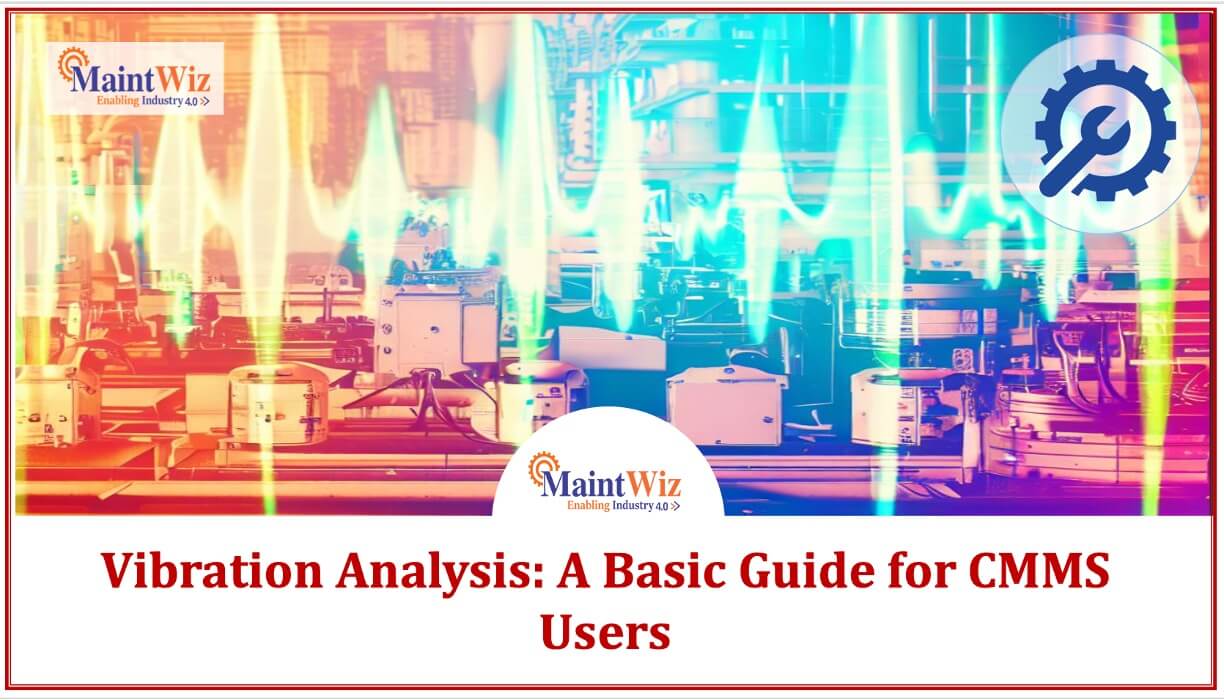
Welcome to the ultimate guide to Vibration Analysis for CMMS users. In this comprehensive guide, we will explore the world of vibration analysis from the perspective of Asset Management and Plant Maintenance. Vibration analysis is a powerful tool in predictive maintenance, and understanding its intricacies can revolutionize how you manage your assets. We will not only delve into the fundamentals of vibration analysis but also highlight the role of CMMS (Computerized Maintenance Management System) in harnessing the full potential of this technology.
Table of Contents
Introduction to Vibration Analysis
What is Vibration Analysis?
Vibration analysis is a predictive maintenance technique that involves monitoring the vibrations of machinery and equipment to detect potential issues before they lead to breakdowns. It provides valuable insights into the health of assets, allowing maintenance teams to take proactive measures.
Importance of Vibration Analysis in Maintenance
Vibration analysis plays a pivotal role in modern maintenance practices. Its significance lies in its ability to identify problems early, reduce downtime, extend equipment lifespan, and ultimately save costs. By analyzing vibrations, maintenance professionals can gain a deep understanding of asset health.
Role of CMMS in Vibration Analysis
A CMMS, such as MaintWiz, serves as the central hub for managing maintenance activities. When it comes to vibration analysis, CMMS software plays a crucial role in the following ways:
- Collecting and storing vibration data from sensors and equipment.
- Providing real-time alerts and notifications when abnormal vibrations are detected.
- Generating work orders based on vibration alerts for timely maintenance actions.
- Analyzing historical vibration data to identify trends and patterns.
With CMMS integration, organizations can streamline their maintenance processes and ensure that vibration analysis is an integral part of their overall maintenance strategy.
Understanding Vibration Metrics
Types of Vibration Metrics (RMS, Peak, Peak-to-Peak)
Vibration data is represented using various metrics, each providing specific insights into equipment health. Understanding these metrics is fundamental to effective vibration analysis:
- Root Mean Square (RMS): It measures the average magnitude of vibration and is useful for assessing overall vibration levels.
- Peak: This metric captures the highest vibration amplitude during a measurement period, highlighting the most severe vibrations.
- Peak-to-Peak: It measures the difference between the highest and lowest vibration points, offering insights into the vibration range.
Units of Measurement (Acceleration, Velocity, Displacement)
Vibration can be measured in different units, each representing a different aspect of motion. The choice of unit depends on the type of analysis required:
- Acceleration (m/s²): It measures the rate of change of velocity and is often used to assess high-frequency vibrations.
- Velocity (mm/s): This unit measures the speed of motion and is suitable for monitoring equipment with moderate vibration frequencies.
- Displacement (µm): Displacement measures the movement of an object from its rest position and is ideal for low-frequency vibration analysis.
Interpreting Vibration Data
Interpreting vibration data is a critical aspect of vibration analysis. It involves analyzing the collected data to understand the state of equipment and identify potential issues. Some key aspects of data interpretation include:
- Frequency analysis to identify dominant vibration frequencies.
- Recognizing spectral peaks in the data and understanding their significance.
- Detecting fault signatures that indicate specific issues within the machinery.
Effective data interpretation requires a deep understanding of the equipment being monitored and the ability to correlate vibration data with potential faults.
Vibration Sensors and Data Collection
Types of Vibration Sensors (Accelerometers, Proximity Probes)
The choice of vibration sensors is crucial for accurate data collection. Different types of sensors are available, including:
- Accelerometers: These sensors measure acceleration and are widely used for general vibration monitoring.
- Proximity Probes: Proximity probes are used for measuring the distance between the probe tip and a target surface, making them suitable for detecting shaft vibrations.
Choosing the right sensor depends on the equipment being monitored and the type of vibration analysis required.
Data Collection Methods
Vibration data can be collected using various methods, depending on the monitoring strategy:
- Continuous monitoring involves the real-time collection of vibration data, providing immediate insights into equipment health.
- Periodic monitoring collects data at predetermined intervals, allowing for regular checks on equipment condition.
- Portable data collectors are used to gather data manually and are ideal for equipment that doesn’t require continuous monitoring.
The choice of data collection method should align with maintenance goals and equipment criticality.
Sensor Placement and Calibration
Proper sensor placement and calibration are essential for accurate data collection. Sensors must be positioned on the equipment in a way that captures relevant vibrations. Calibration ensures that sensor readings align with actual vibration levels, maintaining data accuracy.
Benefits of Vibration Analysis
Early Fault Detection
One of the primary benefits of vibration analysis is early fault detection. By continuously monitoring vibrations, maintenance teams can detect abnormalities and potential faults in their early stages. This early detection allows for timely maintenance interventions, preventing costly breakdowns and reducing downtime.
Improved Asset Reliability
Vibration analysis contributes significantly to improved asset reliability. By addressing issues proactively, organizations can extend the lifespan of their equipment. This not only reduces replacement costs but also enhances overall operational efficiency.
Cost Savings Through Predictive Maintenance
Predictive maintenance, driven by vibration analysis, optimizes maintenance schedules and resource allocation. It reduces spare parts costs, minimizes labor expenses, and eliminates the need for unnecessary preventive maintenance. This results in substantial cost savings for organizations.
Overall, the benefits of vibration analysis translate into a more efficient and cost-effective maintenance strategy.
Interpreting Vibration Spectra
Frequency Analysis
Frequency analysis is a critical aspect of interpreting vibration spectra. It involves analyzing the frequency components of vibration data. This analysis helps identify the sources of vibrations, such as unbalance, misalignment, or bearing defects. By pinpointing the dominant frequencies, maintenance teams can focus their efforts on specific issues.
Spectral Peaks and Their Significance
Spectral peaks in vibration spectra indicate the presence of specific frequencies associated with faults or anomalies. Understanding the significance of these peaks is essential for fault diagnosis. Different types of faults produce unique spectral patterns, allowing maintenance professionals to identify the exact nature of the problem.
Detecting Fault Signatures
Vibration spectra often exhibit unique fault signatures. These signatures are characteristic patterns that correspond to specific faults. For example, a cracked bearing may produce a distinct spectral pattern. Detecting these fault signatures is a valuable skill in vibration analysis and aids in precise issue identification.
Integration with CMMS
Incorporating Vibration Data into CMMS
CMMS integration is a game-changer for organizations looking to maximize the benefits of vibration analysis. Here’s how vibration data seamlessly integrates into CMMS:
- Vibration data is collected by sensors and transmitted to the CMMS system.
- CMMS processes the data in real time, identifying abnormal vibrations.
- When predefined alert thresholds are exceeded, CMMS generates work orders automatically.
- Maintenance teams receive notifications and take immediate action, preventing potential failures.
This integration ensures that vibration analysis is an integral part of the maintenance workflow, enhancing asset reliability.
Creating Work Orders Based on Vibration Alerts
CMMS can automatically generate work orders based on vibration alerts. These work orders contain detailed information about the detected issue, including the equipment involved, the severity of the problem, and recommended actions. Maintenance teams can then prioritize and execute these work orders efficiently.
Historical Data Analysis
CMMS stores historical vibration data, allowing organizations to perform in-depth analysis over time. By examining trends and patterns in historical data, maintenance professionals can make data-driven decisions about asset maintenance strategies. Historical data analysis also aids in identifying recurring issues and their root causes.
Setting Up Vibration Monitoring Programs
Developing Monitoring Strategies
Effective vibration monitoring programs require well-defined strategies. Here are some key considerations:
- Determine the criticality of equipment to prioritize monitoring efforts.
- Establish monitoring frequencies based on equipment usage and performance history.
- Define alarm thresholds that trigger maintenance actions when exceeded.
Developing a robust monitoring strategy ensures that vibration analysis is focused on the most critical assets.
Establishing Alert Thresholds
Alert thresholds are predetermined levels of vibration beyond which maintenance action is required. Setting appropriate alert thresholds is essential to avoid unnecessary alarms and ensure that maintenance teams focus on genuinely critical issues. The right balance between sensitivity and specificity is key to effective alerting.
Frequency of Data Collection
The frequency of data collection depends on several factors, including equipment criticality, historical performance data, and the cost of monitoring. Critical assets may require continuous monitoring, while less critical equipment may be monitored periodically. Finding the optimal data collection frequency is essential to efficient vibration analysis.
Common Challenges in Vibration Analysis
Data Quality and Consistency
Maintaining data quality and consistency in vibration analysis can be challenging. Factors such as environmental conditions, sensor placement, and calibration can impact the accuracy of data. Organizations must implement rigorous data quality control measures to ensure reliable results.
Training and Skill Gaps
Effectively interpreting vibration data requires specialized training and expertise. Many organizations face skill gaps in this area. Investing in training and certification programs for maintenance personnel is crucial to bridge these gaps and improve the accuracy of analysis.
Integrating Vibration Analysis into Existing Maintenance Practices
Integrating vibration analysis into established maintenance practices can be met with resistance and operational challenges. Maintenance teams may need to adapt to new workflows and procedures. Effective change management and communication are essential to overcoming these challenges.
Future Trends in Vibration Analysis
Advances in Sensor Technology
The field of vibration analysis continues to evolve, with ongoing advances in sensor technology. New sensors are becoming more sensitive and reliable, enabling the detection of even subtle vibrations. These advances enhance the accuracy of data collection and fault diagnosis.
AI and Machine Learning in Vibration Analysis
Artificial intelligence (AI) and machine learning (ML) are making significant inroads into vibration analysis. These technologies can automatically analyze vast amounts of vibration data, identifying patterns and anomalies that may go unnoticed by human analysts. AI-driven analysis improves the speed and accuracy of fault detection.
Industry 4.0 and Vibration Monitoring
The concept of Industry 4.0 , characterized by the integration of digital technologies into industrial processes, is transforming vibration monitoring. Real-time data analysis, cloud-based solutions, and IoT (Internet of Things) connectivity are enabling more comprehensive and proactive vibration monitoring. This evolution aligns with the broader trend of predictive maintenance.
Conclusion
In conclusion, vibration analysis is a powerful tool for predictive maintenance, and its integration with CMMS systems can revolutionize asset management. This guide has explored the fundamentals of vibration analysis, its benefits, and the role of CMMS in leveraging this technology. As manufacturing industries embrace predictive maintenance, understanding vibration analysis is essential for improving equipment reliability, reducing costs, and staying competitive.
Key Takeaways:
- Vibration analysis is crucial for predictive maintenance and early fault detection.
- CMMS integration streamlines vibration data management and work order generation.
- Understanding vibration metrics and spectral analysis is essential for accurate fault diagnosis.
- Future trends include advances in sensor technology, AI, and Industry 4.0 integration.
Unlock the potential of vibration analysis with MaintWiz CMMS. Discover how our integrated solution can transform your maintenance practices and maximize asset reliability. Get started today!

Jai Balachandran is an industry expert with a proven track record in driving digital transformation and Industry 4.0 technologies. With a rich background in asset management, plant maintenance, connected systems, TPM and reliability initiatives, he brings unparalleled insight and delivery excellence to Plant Operations.
Recent Posts
- From Chaos to Order: Simplifying Maintenance Management with Technology
- From Crisis to Control:Regaining Stability with Effective Breakdown Response
- Avoiding Pitfalls: The 7 Biggest Mistakes Plant Managers Make in Maintenance
- Quality Matters: Improve OEE by Reducing Defects and Rework with MaintWiz CMMS
- How to Implement an Effective Lubrication Program for Your Plant Maintenance Strategy
Recent Comments
Company




